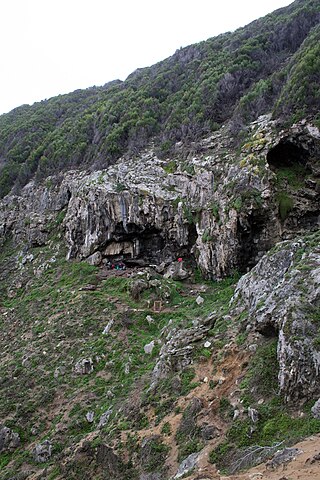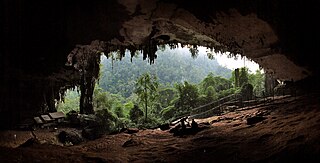
The Red "Lady" of Paviland is an Upper Paleolithic partial male skeleton dyed in red ochre and buried in Wales 33,000 BP. The bones were discovered in 1823 by William Buckland in an archaeological dig at Goat's Hole Cave which is a limestone cave between Port Eynon and Rhossili on the Gower Peninsula, near Swansea in south Wales. Buckland believed the skeleton was a Roman era female. Later, William Solace examined Goat's Cave Paviland in 1912. There, Solace found flint arrow heads and tools and correctly concluded that the skeleton was in fact a male hunter-gatherer or warrior during the last Ice Age.

Creswell Crags is an enclosed limestone gorge on the border between Derbyshire and Nottinghamshire, England, near the villages of Creswell and Whitwell. The cliffs in the ravine contain several caves that were occupied during the last ice age, between around 43,000 and 10,000 years ago. Its caves contain the northernmost cave art in Europe. The evidence of occupation found in the rich series of sediments that accumulated over many thousands of years is regarded as internationally unique in demonstrating how prehistoric people managed to live at the extreme northernmost limits of their territory during the Late Pleistocene period.

Blombos Cave is an archaeological site located in Blombos Private Nature Reserve, about 300 km east of Cape Town on the Southern Cape coastline, South Africa. The cave contains Middle Stone Age (MSA) deposits currently dated at between c. 100,000 and 70,000 years Before Present (BP), and a Late Stone Age sequence dated at between 2000 and 300 years BP. The cave site was first excavated in 1991 and field work has been conducted there on a regular basis since 1997, and is ongoing.

Niah National Park, located within Miri Division, Sarawak, Malaysia, is the site of the Niah Caves which are an archeological site.

Gough's Cave is located in Cheddar Gorge on the Mendip Hills, in Cheddar, Somerset, England. The cave is 115 m (377 ft) deep and is 3.405 km (2.12 mi) long, and contains a variety of large chambers and rock formations. It contains the Cheddar Yeo, the largest underground river system in Britain.

Gorham's Cave is a sea-level cave in the British overseas territory of Gibraltar. Though not a sea cave, it is often mistaken for one. Considered to be one of the last known habitations of the Neanderthals in Europe, the cave gives its name to the Gorham's Cave complex, which is a combination of four distinct caves of such importance that they are combined into a UNESCO World Heritage Site, the only one in Gibraltar. The three other caves are Vanguard Cave, Hyaena Cave, and Bennett's Cave.

Kendrick's Cave on the Great Orme, Llandudno, Wales, was the site of important archaeological finds by Thomas Kendrick in 1880. The site is a small natural cavern on the south of the Great Orme Head, a limestone massif on the seaward side of Llandudno.

Cathole Cave, Cat Hole Cave or Cathole Rock Cave, is a cave near Parc Cwm long cairn at Parc le Breos, on the Gower Peninsula, Wales. It is a steep limestone outcrop, about 200 yards (180 m) north of the cromlech along the Parc le Breos Cwm valley and near the top of the gorge, about 50 feet (15 m) from the valley floor. The cave is a deep triangular fissure penetrating the hillside and narrowing towards the top. It has two entrances, with a natural platform outside the larger of the two. It is about seven 1⁄2 miles (12 km) west south–west of Swansea, Wales, in what is now known as Coed y Parc Cwm at Parc le Breos, on the Gower Peninsula.

Wynfrid Lawrence Henry Duckworth was a British anatomist, and former Master of Jesus College, Cambridge. The Duckworth Laboratory at Cambridge University is named after him.

Ibex Cave is a limestone cave on the Rock of Gibraltar which has yielded stone artifacts of Mousterian tradition. It was discovered in 1975. It is so named as an ibex skull was found within the cave which would have been hunted by the Neanderthals of Gibraltar thousands of years ago. Ibex Cave was named and excavated by the Gibraltar Museum in 1994. Its first formal description was in 1999. It is protected by the Heritage and Antiquities Act 2018 of the Government of Gibraltar.

Martin's Cave is a cave in the British Overseas Territory of Gibraltar. It opens on the eastern cliffs of the Rock of Gibraltar, below its summit at O'Hara's Battery. It is an ancient sea cave, though it is now located over 700 feet (210 m) above the shore of the Mediterranean Sea. It is only accessible because Martin's Path was constructed.
Beefsteak Cave is a cave in the British Overseas Territory of Gibraltar. It is located in the south of the Rock, between Europa Point and Windmill Hill.
Collin's Cave is a cave in the British Overseas Territory of Gibraltar. It is located in the northeastern part of the Rock, between Reservoir Fissure and Middle Hill Cave. The cave is above Catalan Bay. It is one of the many caves in Gibraltar. It is believed to be archaeologically important and is listed in the government's Heritage and Antiquities Act 2018.
The Genista Caves are a series of caves located under Windmill Hill in the British Overseas Territory of Gibraltar. Fossils of various mammals and human remains were discovered here in the mid-1860s. The name of the caves is a play on words based on Captain Frederick Brome's name, who discovered them.

The Goat's Hair Twin Caves are in the British Overseas Territory of Gibraltar. The caves are listed in the Heritage and Antiquities Act as they are sites of Palaeolithic and Neolithic archaeology.

Holy Boy's Cave is a cave in the British Overseas Territory of Gibraltar. It is one of the largest of the many caves in Gibraltar and it is on the eastern side of the Rock, near Cave S. It is believed to be archaeologically important and is listed in the Heritage and Antiquities Act 2018.
Judge's Cave is a cave in the British Overseas Territory of Gibraltar. Human remains dated to the late prehistoric period have been unearthed in the cave. This Neolithic Shelter is protected by the law of Gibraltar.
Devil's Tower Cave is a cave in the British Overseas Territory of Gibraltar. Archaeologist Dorothy Garrod found a Neanderthal skull in the cave which, together with other evidence found in this cave, shows it was used as a rock shelter by the Neanderthals of Gibraltar.

Mediterranean Cave is a cave in the British Overseas Territory of Gibraltar. The cave also has pillboxes and a fallout shelter nearby, these all being mentioned in the government's Heritage and Antiquities Act 2018.

The Neanderthals in Gibraltar were among the first to be discovered by modern scientists and have been among the most well studied of their species according to a number of extinction studies which emphasize regional differences, usually claiming the Iberian Peninsula partially acted as a “refuge” for the shrinking Neanderthal populations and the Gibraltar population of Neanderthals as having been one of many dwindling populations of archaic human populations, existing just until around 42,000 years ago. Many other Neanderthal populations went extinct around the same time.
















